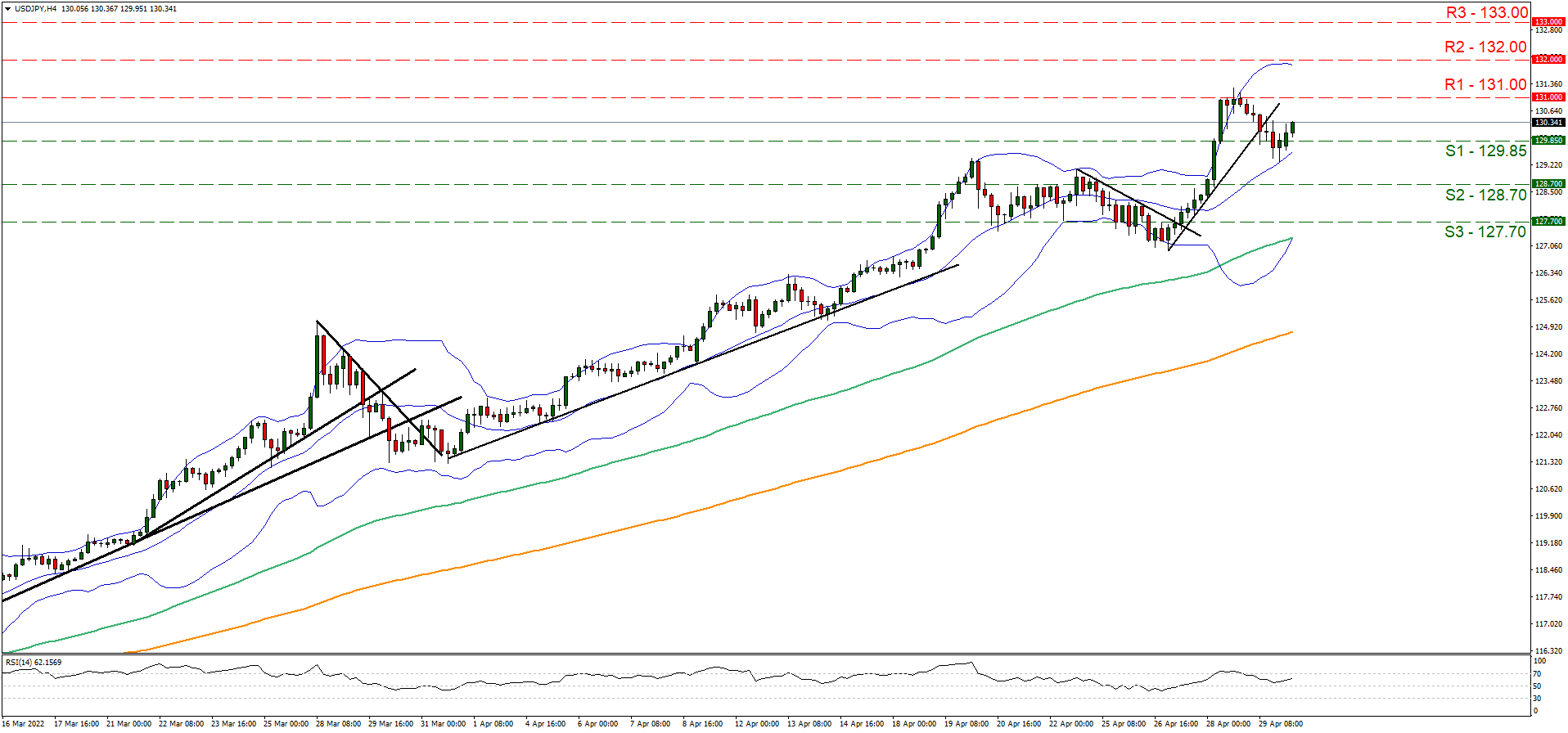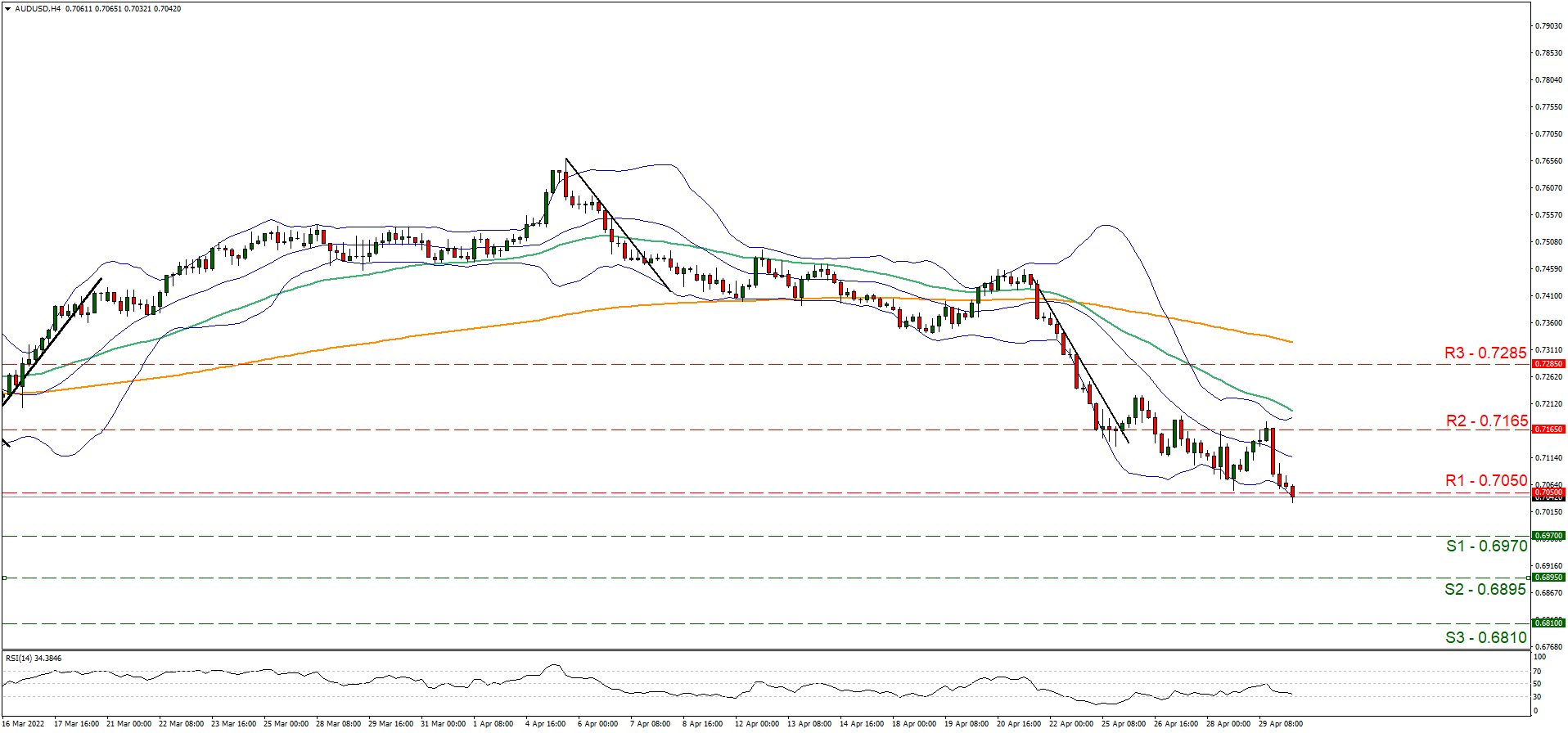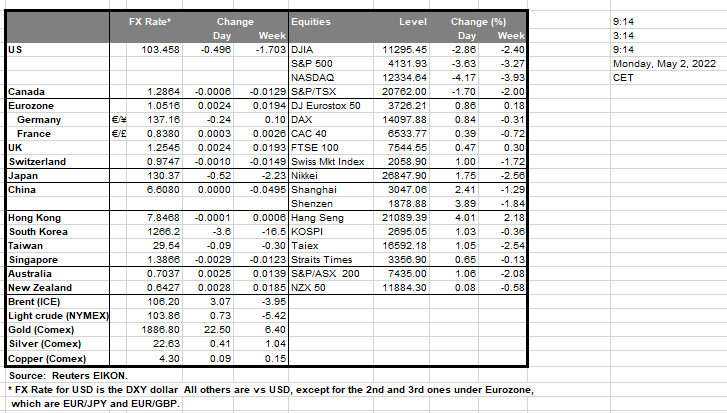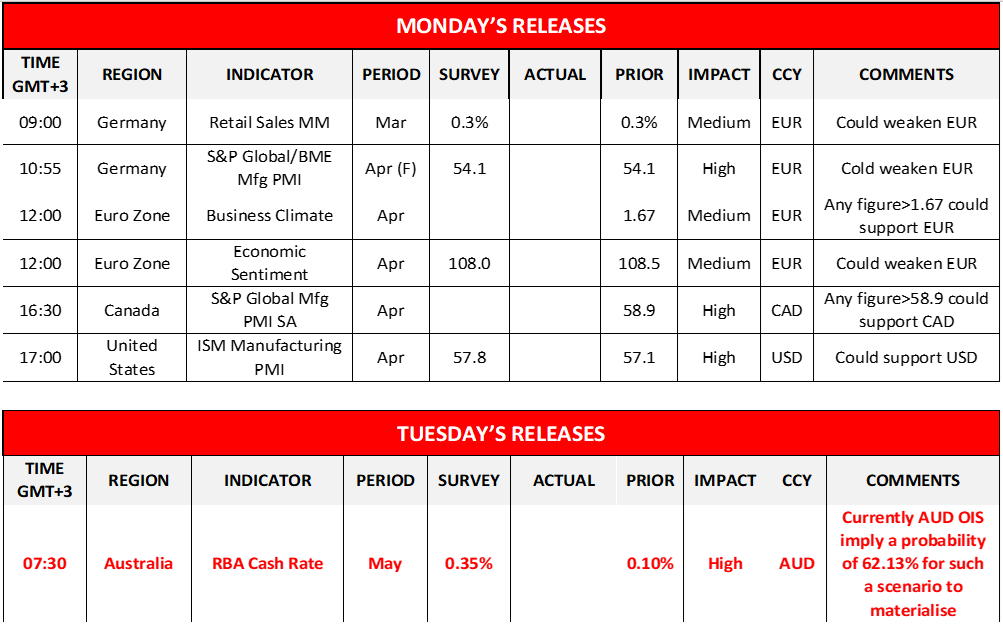US stockmarkets dropped substantially on Friday as the market’s interest turns towards the Fed’s interest rate decision on Wednesday and the US employment report for April on Friday. It seems that the USD bulls have halted the currency’s ascent and the sideways movement against JPY is characteristic, yet the Fed’s interest rate decision along with the April employment data could shake the markets and provide support for the greenback once again. Overall the worries for a possible slowdown if not a mild recession for the US economy, the ongoing lockdowns in China which are threatening the global economic recovery and the ongoing war in Ukraine with its collateral damage due to sanctions imposed on Russia tend to weigh on the market sentiment. It seems that this pessimistic sentiment may have also weighed on commodity currencies such as the AUD, NZD and CAD, which are more sensitive to any fluctuations of the global economic recovery.
Tomorrow Aussie traders are expected to focus on the release of RBA’s interest rate decision and the bank is expected to hike rates by 25 basis points and its characteristic that AUD OIS imply a probability of 62.13% for such a scenario to materialize. It should be noted that Reuters, citing a recent survey among economists expects the bank to proceed with only a 15-basis points rate hike tomorrow. The acceleration of the headline rate to 5.1% yoy, in Q1, may now force the bank to leave any hesitation behind it and start tightening its monetary policy in a more intense and fast manner. Should the bank proceed with a rate hike and Governor Lowe express a hawkish tone in his accompanying statement we may see the Aussie getting some substantial support. On the other hand, should the bank proceed with a 15-basis points rate hike and/or express cautiousness and hesitation we may see the support for the AUD being limited. Also note that, the bank is expected to provide new projections on the path of inflation for Australia.
USD/JPY seems to maintain a rangebound movement after failing to clearly break the 129.85 (S1) support line. We tend to maintain a bias for a sideways movement for the pair as long as it remains between the 129.85 (S1) and the 131.00 (R1) levels, yet we note that the RSI indicator below our 4-hour chart is above the reading of 50, which may imply some bullish tendencies for the pair. Should the bulls actually take charge of the pair’s direction once again, we may see USD/JPY breaking the 131.00 (R1) resistance line and aim for the 132.00 (R2) level. Should the bears take over, we may see the pair breaking the 129.85 (S1) support line and aim for the 128.70 (S2) level.
AUD/USD’s bearish tendencies seem to have restarted, as the pair’s price action has broken below the 0.7050 (R1) support line, now turned to resistance. Also the RSI indicator below our 4-hour chart has a downward slope, aiming for the reading of 30, which may also provide an advantage for the bears. Should the selling interest be maintained we may see AUD/USD aiming if not breaching the 0.6970 (S1) support line, while even lower we note the 0.6895 (S2) support level. On the other hand should the pair find fresh buying orders along its path, we may see it breaking the 0.7050 (R1) resistance line and aim for the 0.7165 (R2) level.
Today’s events and expectations
Today we note the release from Germany of March’s retail sales, April’s final manufacturing PMI figure, Eurozone’s business climate and economic sentiment for April, while we also note Canada’s S&P global manufacturing PMI figure for April as well as the US April ISM manufacturing PMI.
As for the rest of the week
Besides RBA’s interest rate decision on Tuesday, we also note the release of the US factory orders for March in the American session. On Wednesday we note New Zealand’s employment data for Q1, Australia’s retail sales for March, Canada’s trade data for March, the US ISM non-manufacturing PMI figure for April and most importantly the Fed’s interest rate decision. On Thursday we get Australia’s trade data for March, Germany’s industrial orders for March, UK’s Halifax house prices for April, Switzerland’s and Turkey’s CPI rates for April, Norgesbank’s interest rate decision, BoE’s interest rate decision and CNB’s interest rate decision, along with the US weekly initial jobless claims figure. On Friday we get from Japan Tokyo’s CPI rates for April, Germany’s industrial output for March the US employment report for April with its NFP figure and Canada’s employment data for April.
USD/JPY H4 Chart

Support: 129.85 (S1), 128.70 (S2), 127.70 (S3)
Resistance: 131.00 (R1), 132.00 (R2), 133.00 (R3)
AUD/USD H4 Chart

Support: 0.6970 (S1), 0.6895 (S2), 0.6810 (S3)
Resistance: 0.7050 (R1), 0.7165 (R2), 0.7285 (R3)



If you have any general queries or comments relating to this article please send an email directly to our Research team at research_team@ironfx.com
Disclaimer:
This information is not considered as investment advice or an investment recommendation, but instead a marketing communication. IronFX is not responsible for any data or information provided by third parties referenced, or hyperlinked, in this communication.













